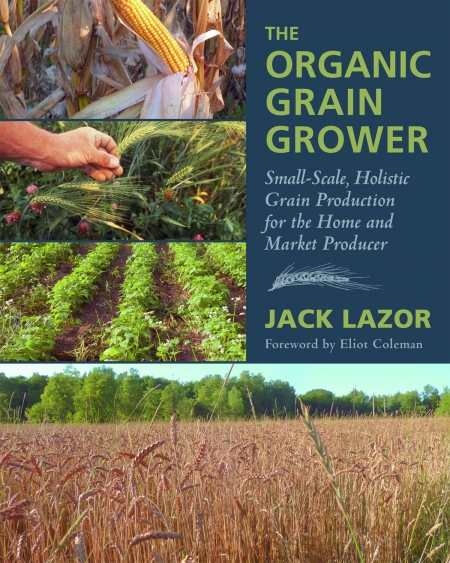The Organic Grain Grower
Small-Scale Holistic Grain Production for the Home and Market Producer
Lazor is as handy with a pen as with a plow in this helpful guide for any aspect of organic farming.
Longtime farming pioneer Jack Lazor has progressed from a back-to-the-land idealist to the co-manager, with his wife, of a profitable dairy and grain business, Butterworks Farm in Westfield, Vermont. In The Organic Grain Grower, he shares his considerable experience and expertise with new generations of holistic home and market grain producers.
Lazor’s book starts with the history of grain production in his local region; early settlers found that northern New England offered a good climate for wheat, vital for animal fodder and bread making. Today, “the rebirth of grain growing” is not just common sense, but fun, Lazor enthusiastically reports. He takes readers through soil fertility and tillage, to the crucial matter of storage (“mice … have an uncanny ability to … burrow into bags that you can’t see from the outside of the pile”), drying, screening, grinding, and grading. He recommends equipment, including less expensive “retired” machinery. Grains covered are corn, wheat, barley, oats, rye, spelt, triticale, buckwheat, and flax, plus soybeans and other legumes.
To Lazor, organic methods are second nature. He advises dealing with grain diseases or potential outbreaks by purchasing clean seeds, testing soil rigorously to be sure the right conditions pertain, and treating weeds with concoctions like molasses, seaweed, and liquid calcium. Lazor retains an intelligent, optimistic view of grain growing. He never lets us forget that farming is hard work and declares, “The successes have been ever so sweet.”
The book is very well organized, including a large section of clear, helpful photos. Though he is not averse to employing newfangled machinery if it does the job well, Lazor takes pride in using older farming equipment that is less complicated than modern counterparts, and some examples of these are illustrated.
The Organic Grain Grower is more than 500 pages, with a colorful, informative cover. Anyone seriously considering growing grain for animal feed, human consumption, or sale will find value in this manual. It would also be beneficial for those interested in any aspect of organic farming, since the sound advice given for grains could apply to any crop.
The foreword by author Eliot Coleman (The Winter Harvest Handbook) praises Lazor as the person “who inspired the movement” back to the “small farm’s grain heritage.” Lazor is as handy with a pen as with a plow, making even grain diseases sound interesting (“there is nothing like a mid-June thunderstorm to set up wheat plants for an invasion of … rust”). His flowing style demonstrates both hard knowledge and old world graces, as he modestly expresses the hope that the book “will help people avoid some of the mistakes that I have made.”
Another outstanding offering from Chelsea Green Publishing, Lazor’s guide will doubtless plant the seeds of inspiration among beginners and old hands alike as they tackle the complexities of grain growing and organic agriculture, and will do its part to propagate more general interest in the subject.
Reviewed by
Barbara Bamberger Scott
Disclosure: This article is not an endorsement, but a review. The publisher of this book provided free copies of the book and paid a small fee to have their book reviewed by a professional reviewer. Foreword Reviews and Clarion Reviews make no guarantee that the publisher will receive a positive review. Foreword Magazine, Inc. is disclosing this in accordance with the Federal Trade Commission’s 16 CFR, Part 255.

